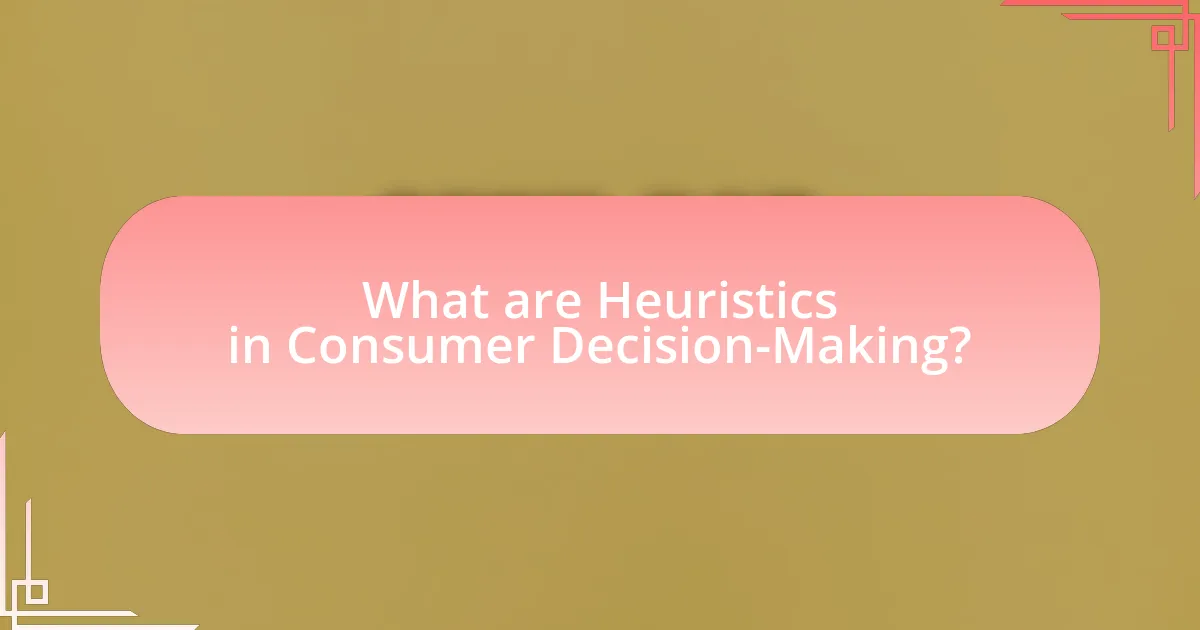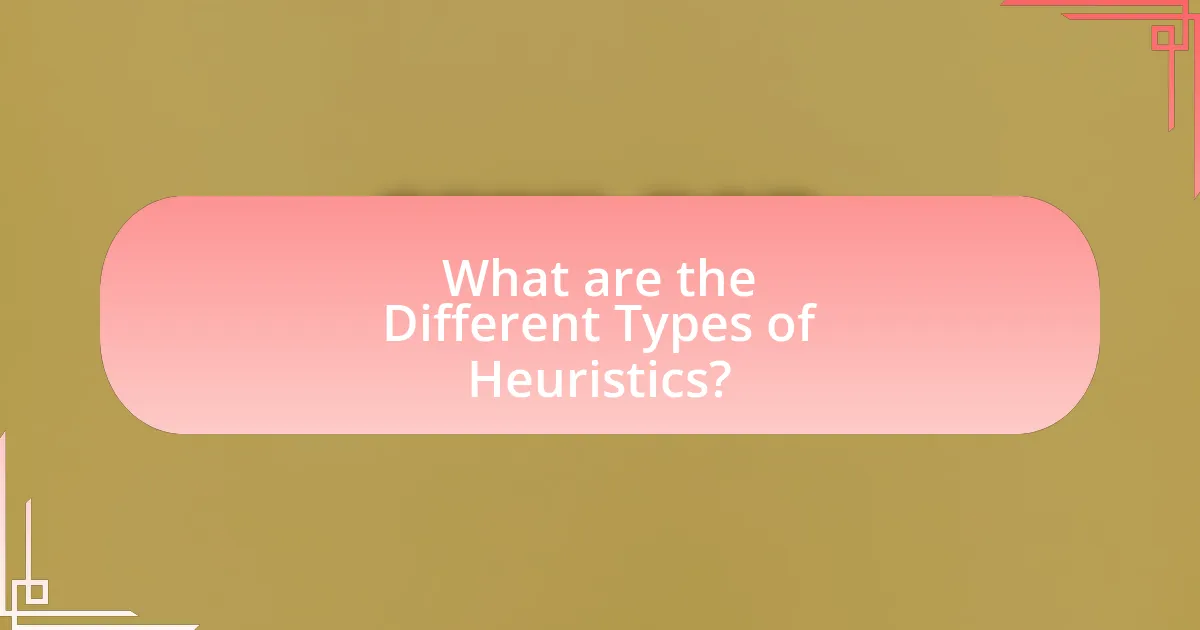Heuristics are mental shortcuts that simplify consumer decision-making processes, allowing individuals to make quick judgments with minimal cognitive effort. This article explores various types of heuristics, including availability, representativeness, and anchoring, and their influence on consumer behavior, brand loyalty, and marketing strategies. It highlights how businesses can leverage these cognitive strategies to enhance consumer engagement and decision-making efficiency while addressing ethical considerations in their application. The discussion includes practical tips for effectively utilizing heuristics in marketing to drive sales and improve customer satisfaction.

What are Heuristics in Consumer Decision-Making?
Heuristics in consumer decision-making are mental shortcuts that simplify the process of making choices. These cognitive strategies allow consumers to make quick judgments and decisions without extensive information processing. For example, the availability heuristic leads consumers to rely on immediate examples that come to mind when evaluating a product, influencing their perception of its popularity or quality. Research by Tversky and Kahneman in 1974 established that heuristics can significantly affect decision outcomes, demonstrating their role in reducing cognitive load and expediting the decision-making process.
How do heuristics influence consumer behavior?
Heuristics significantly influence consumer behavior by providing mental shortcuts that simplify decision-making processes. These cognitive strategies allow consumers to make quick judgments based on limited information, often relying on past experiences or readily available information. For instance, the availability heuristic leads consumers to assess the likelihood of an event based on how easily examples come to mind, which can affect their purchasing decisions. Research by Tversky and Kahneman demonstrates that such heuristics can lead to systematic biases, impacting choices in areas like brand selection and product evaluation.
What are the most common types of heuristics used by consumers?
The most common types of heuristics used by consumers include availability heuristic, representativeness heuristic, and anchoring heuristic. The availability heuristic leads consumers to make decisions based on readily available information or recent experiences, often influencing their perception of risk or frequency. The representativeness heuristic causes consumers to judge the probability of an event based on how similar it is to a prototype, which can lead to biases in decision-making. The anchoring heuristic involves relying heavily on the first piece of information encountered (the “anchor”) when making decisions, affecting subsequent judgments. These heuristics are widely studied in behavioral economics and psychology, demonstrating their significant impact on consumer behavior and decision-making processes.
How do heuristics simplify complex decision-making processes?
Heuristics simplify complex decision-making processes by providing mental shortcuts that reduce the cognitive load required to evaluate multiple options. These cognitive strategies enable individuals to make quicker decisions by relying on readily available information, past experiences, or simple rules of thumb. For instance, the availability heuristic allows people to judge the likelihood of events based on how easily examples come to mind, which can expedite choices in uncertain situations. Research by Tversky and Kahneman demonstrates that heuristics can lead to effective decision-making in many scenarios, despite the potential for biases, thereby illustrating their role in enhancing efficiency and speed in consumer decisions.
Why are heuristics important in marketing strategies?
Heuristics are important in marketing strategies because they simplify decision-making for consumers, allowing them to make quicker choices with less cognitive effort. By leveraging heuristics, marketers can influence consumer behavior through techniques such as social proof, scarcity, and anchoring, which tap into innate psychological shortcuts. For instance, a study by Cialdini (2009) highlights that consumers are more likely to purchase products that are perceived as popular or endorsed by others, demonstrating the effectiveness of social proof as a heuristic in driving sales.
How can marketers leverage heuristics to enhance consumer engagement?
Marketers can leverage heuristics to enhance consumer engagement by simplifying decision-making processes for consumers. By utilizing cognitive shortcuts, such as the availability heuristic, marketers can present relatable and easily recalled information, making products more appealing. For instance, showcasing popular products or customer testimonials can trigger positive associations, leading to increased engagement. Research indicates that consumers often rely on heuristics when faced with complex choices, as demonstrated in a study by Tversky and Kahneman, which highlights how individuals use mental shortcuts to make decisions efficiently. This understanding allows marketers to design campaigns that resonate with consumer psychology, ultimately driving higher engagement rates.
What role do heuristics play in brand loyalty?
Heuristics significantly influence brand loyalty by simplifying decision-making processes for consumers. These mental shortcuts allow individuals to make quick judgments about brands based on past experiences, familiarity, or perceived quality, which fosters a sense of trust and preference. For instance, research indicates that consumers often rely on the availability heuristic, where they choose brands that they can easily recall or recognize, leading to repeat purchases and sustained loyalty. Additionally, the representativeness heuristic plays a role, as consumers may associate certain brands with specific attributes or categories, reinforcing their loyalty based on perceived fit. This reliance on heuristics ultimately streamlines consumer choices, making it more likely for them to remain loyal to brands that consistently meet their expectations.

What are the Different Types of Heuristics?
Heuristics are mental shortcuts that simplify decision-making processes. The different types of heuristics include availability heuristics, which rely on immediate examples that come to mind; representativeness heuristics, which involve judging the probability of an event based on how similar it is to a prototype; and anchoring heuristics, where individuals rely heavily on the first piece of information encountered when making decisions. These heuristics are widely studied in psychology and behavioral economics, demonstrating their influence on consumer behavior and decision-making efficiency.
What are availability heuristics and how do they affect decisions?
Availability heuristics are mental shortcuts that rely on immediate examples that come to mind when evaluating a specific topic, concept, method, or decision. These heuristics affect decisions by leading individuals to overestimate the likelihood of events based on how easily they can recall similar instances, often influenced by recent experiences or media exposure. For instance, after hearing about airplane accidents, a person may perceive flying as more dangerous than it statistically is, impacting their travel choices. This cognitive bias can skew risk assessment and decision-making processes, as individuals may prioritize information that is readily available over more comprehensive data.
How does the availability heuristic impact consumer perception?
The availability heuristic significantly impacts consumer perception by influencing how readily information comes to mind when making purchasing decisions. This cognitive shortcut leads consumers to rely on immediate examples or recent experiences, which can skew their judgment about the frequency or likelihood of certain products or brands. For instance, if a consumer frequently sees advertisements for a specific brand, they may perceive it as more popular or superior, regardless of actual market data. Research by Tversky and Kahneman (1973) demonstrates that individuals often overestimate the importance of information that is easily retrievable, thus affecting their choices and preferences in the marketplace.
What examples illustrate the availability heuristic in action?
The availability heuristic is illustrated by examples such as the perception of airplane travel safety and the frequency of shark attacks. People often overestimate the danger of flying after hearing about a plane crash, despite statistics showing that air travel is significantly safer than car travel. Similarly, after media coverage of a shark attack, individuals may believe that such incidents are more common than they actually are, leading to an exaggerated fear of swimming in the ocean. These examples demonstrate how recent or vivid information can skew an individual’s judgment about risk and frequency, confirming the principles of the availability heuristic.
What is the representativeness heuristic?
The representativeness heuristic is a cognitive shortcut that individuals use to make judgments about the probability of an event based on how closely it resembles a typical case. This heuristic leads people to assess the likelihood of an occurrence by comparing it to an existing mental prototype, often resulting in biased decision-making. For example, if someone encounters a person who is quiet and enjoys reading, they may assume that this individual is a librarian rather than a salesperson, despite the statistical likelihood of encountering more salespeople than librarians. This bias can lead to errors in judgment, as it overlooks relevant statistical information in favor of superficial similarities.
How does the representativeness heuristic shape consumer expectations?
The representativeness heuristic shapes consumer expectations by leading individuals to judge the likelihood of an event based on how closely it resembles a typical case. This cognitive shortcut causes consumers to form expectations based on stereotypes or previous experiences rather than statistical probabilities. For example, if a consumer has had a positive experience with a brand known for high quality, they may expect all products from that brand to be of similar quality, regardless of actual variations. Research by Tversky and Kahneman demonstrates that this heuristic can result in biased decision-making, as consumers often overlook relevant information that contradicts their preconceived notions.
What are the potential pitfalls of relying on the representativeness heuristic?
Relying on the representativeness heuristic can lead to significant pitfalls, including overgeneralization and neglect of base rates. This cognitive shortcut causes individuals to judge the probability of an event based on how similar it is to a prototype, often resulting in misjudgments. For instance, people may assume that a person who is quiet and enjoys reading is more likely to be a librarian than a salesperson, despite the fact that there are far more salespeople than librarians in the population. This misjudgment occurs because the representativeness heuristic overlooks relevant statistical information, leading to biased decision-making. Additionally, it can result in stereotyping, where individuals make assumptions about a group based on limited examples, further distorting perceptions and decisions.

How Can Businesses Effectively Utilize Heuristics?
Businesses can effectively utilize heuristics by implementing decision-making shortcuts that simplify complex processes for consumers. By leveraging cognitive biases, such as the availability heuristic, businesses can present information in a way that makes it more memorable and accessible, thereby influencing consumer choices. For instance, using social proof, like customer testimonials or ratings, can enhance perceived value and trustworthiness, leading to increased sales. Research indicates that 70% of consumers trust online reviews as much as personal recommendations, demonstrating the power of heuristics in shaping purchasing behavior.
What strategies can businesses implement to leverage heuristics?
Businesses can implement strategies such as simplifying choices, using social proof, and framing information effectively to leverage heuristics. Simplifying choices reduces cognitive overload, allowing consumers to make quicker decisions; for instance, offering a limited selection of products can enhance decision-making efficiency. Utilizing social proof, such as customer testimonials or popularity indicators, can influence consumer behavior by tapping into the heuristic that people tend to follow the actions of others. Additionally, framing information in a positive light, such as highlighting benefits rather than drawbacks, can guide consumers toward favorable decisions. These strategies are supported by behavioral economics research, which shows that consumers often rely on mental shortcuts to navigate complex choices, thus validating the effectiveness of these approaches in influencing consumer behavior.
How can product placement utilize heuristics for better sales?
Product placement can utilize heuristics for better sales by strategically embedding products in media content to trigger mental shortcuts that influence consumer behavior. For instance, the mere exposure effect suggests that repeated exposure to a product in a familiar context can enhance consumer preference and increase purchase likelihood. Research indicates that when viewers see products used by relatable characters, they are more likely to develop positive associations with those products, leading to a 20% increase in brand recall and a 15% increase in purchase intent, as shown in studies by the Journal of Advertising Research. By leveraging these cognitive biases, brands can effectively enhance their visibility and desirability, ultimately driving sales.
What role does pricing play in heuristic-based decision-making?
Pricing serves as a critical heuristic in decision-making by simplifying the evaluation of options for consumers. When faced with multiple choices, individuals often rely on price as a shortcut to infer quality or value, allowing them to make quicker decisions without extensive analysis. Research indicates that consumers frequently use price as a cue; for instance, a study published in the Journal of Consumer Research found that higher prices are often associated with higher perceived quality, influencing purchasing behavior. This reliance on pricing as a heuristic can lead to faster decisions, but it may also result in biases, such as overlooking better alternatives that are priced lower.
What are the ethical considerations when using heuristics in marketing?
The ethical considerations when using heuristics in marketing include the potential for manipulation, the risk of oversimplification, and the impact on consumer autonomy. Marketers must ensure that heuristics do not exploit cognitive biases to mislead consumers, as this can lead to unethical practices such as false advertising or deceptive pricing strategies. For example, using scarcity heuristics to create a false sense of urgency can pressure consumers into making hasty decisions without fully understanding the implications. Additionally, oversimplifying complex choices through heuristics may deprive consumers of necessary information, undermining their ability to make informed decisions. Ethical marketing practices should prioritize transparency and respect for consumer autonomy, ensuring that heuristics serve to enhance understanding rather than deceive.
How can businesses ensure they are using heuristics responsibly?
Businesses can ensure they are using heuristics responsibly by implementing a framework that prioritizes transparency, ethical considerations, and continuous evaluation of decision-making processes. This involves clearly communicating the heuristics used in marketing and product design to consumers, thereby fostering trust and informed choices. Additionally, businesses should regularly assess the impact of these heuristics on consumer behavior and outcomes, ensuring they do not exploit cognitive biases in harmful ways. Research indicates that responsible use of heuristics can enhance customer satisfaction and loyalty, as seen in studies that link ethical marketing practices to positive consumer perceptions.
What are the potential consequences of manipulating heuristics?
Manipulating heuristics can lead to significant consequences, including biased decision-making and unethical consumer behavior. When heuristics, which are mental shortcuts used to simplify decision processes, are manipulated, individuals may make choices based on incomplete or misleading information. This can result in consumers overvaluing certain products or services, leading to poor purchasing decisions. For instance, research by Tversky and Kahneman highlights that reliance on heuristics can cause systematic errors in judgment, such as the availability heuristic, where individuals assess the probability of events based on how easily examples come to mind. Consequently, this manipulation can undermine trust in brands and distort market dynamics, ultimately harming both consumers and businesses.
What practical tips can businesses apply to leverage heuristics effectively?
Businesses can leverage heuristics effectively by simplifying decision-making processes for consumers. One practical tip is to present information in a clear, concise manner, which reduces cognitive load and helps consumers make quicker choices. For instance, using visual aids like infographics can enhance understanding and retention of key messages. Another tip is to utilize social proof, such as customer testimonials or ratings, which can influence consumer behavior by tapping into the heuristic of conformity. Additionally, businesses should create default options that guide consumers toward favorable choices, as defaults often lead to higher acceptance rates. Research indicates that when options are framed positively, such as highlighting benefits rather than drawbacks, consumers are more likely to respond favorably, demonstrating the effectiveness of heuristic application in marketing strategies.


